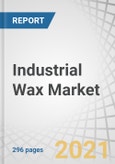The Industrial wax market was USD 7.3 billion in 2020 and is projected to reach USD 8.9 billion by 2025, at a CAGR of 4% from 2020. Waxes are the main constituents for the production of candles across the globe. Majorly, paraffin, microcrystalline, animal, and vegetable wax are used for manufacturing various types of candles based on the requirement such as fragrance, color, burn time and environmental friendliness. These candles are used for decoration, festive ceremonies due to their religious belief, lifestyle, and living habit.
The increase in population, changing lifestyle, living standards increase in per-capita income, and growing old concerns are the major factors supporting the growth of the cosmetics and personal care industry. The global cosmetic market was over USD 246 billion in 2019 and had registered a growth of 5.5% as compared to 2018. Also, the growth of cosmetic and personal care products is expected to register double-digit growth in developing countries such as China, India, and ASEAN countries.
The cosmetic industry uses wax for various applications such as lipsticks, baby products, eye, and facial makeup, nail care, skincare, suntan/sunscreen, and fragrance due to their structuring agents, rigidity, glossy, flexibility, stickiness, and barrier properties. Beeswax, candelilla, carnauba, and paraffin waxes are among the most commonly used industrial wax for cosmetics applications.
COVID-19 impact on the industrial wax market.
COVID-19 outbreak has significant impact on most of the North American and European countries, especially the U.S., Italy, Spain, the UK, France, and Germany. The impact was further intensified by declining oil and gas prices. The suspension of manufacturing activities and disruption of the supply chain has resulted in a decline for industrial wax from these countries. Further, declining demand for cosmetics, candles, and consumer products across the globe wherein the waxes are used has resulted in a slump in industrial wax demand across the globe.
Candles industry is estimated to have the largest share in Industrial wax market.
Candles are primarily made from microcrystalline wax, beeswax, and plant wax such as carnauba, soybean, and bayberry wax). Candles are one of the oldest applications of wax, which is still the fastest-growing market owing to the increasing importance of decorative items and therapeutic uses. The growing importance of candles for religious purposes has forced the wax manufacturers to produce wax from vegetable-based materials such as soybean oil, palm oil, beeswax, and even tallow. This has triggered the demand for vegetable-based waxes globally.
APAC projected to account for the largest share of the industrial wax market during the forecast period.
Asia-Pacific is largest market for industrial wax due to growing economies such as China, India, Japan, and other Asian countries like South Korea and Indonesia. The Asia-Pacific has the largest market for the candle industry. Within Asia, China dominates the market for candles and the packaging industry. The growth is led by rapid industrialization, growing demand from various applications, and growing per capita income in these regions. The growing demand for candles is derived from decoration, religious belief, and various lifestyle and living habits.
- By Company Type: Tier 1: 40%, Tier 2: 20%, and Tier 3: 40%
- By Designation: C-level Executives: 20%, Directors: 20%, and Others: 60%
- By Region: North America: 40%, Europe: 15%, Asia Pacific: 40%, and Rest of World: 5%
The Industrial wax market comprises major manufacturers such as Exxon Mobil Corporation (U.S.), Royal Dutch Shell PLC (Netherlands), Sinopec (China), Sasol Ltd (South Africa), CEPSA (Spain), Hollyfrontier Corporation (U.S.), Calumet Specialty Products Partners (US), Gandhar Oil refinery (India), Numaligarh Refinery Limited (India), Petróleo Brasileiro (Brazil), THE PJSC Lukoil Oil Company (Russia).
Research Coverage
The market study covers the industrial wax market across various segments. It aims at estimating the market size and the growth potential of this market across different segments based on type, application, and region. The study also includes an in-depth competitive analysis of key players in the market, along with their company profiles, key observations related to their products and business offerings, recent developments undertaken by them, and key growth strategies adopted by them to enhance their position in the industrial wax market.
Key Benefits of Buying the Report
The report is expected to help the market leaders/new entrants in this market with information on the closest approximations of the revenue numbers of the overall industrial wax market and its segments and sub-segments. This report is projected to help stakeholders understand the competitive landscape of the market and gain insights to improve the position of their businesses and plan suitable go-to-market strategies. The report also aims at helping stakeholders understand the pulse of the market and provides them with information on the
Table of Contents
Companies Mentioned
- CEPSA
- Calumet Specialty Products Partners, L.P.
- China National Petroleum Corporation
- Evonik Industries
- Exxon Mobil Corp
- Gandhar Oil Refinery
- HCI
- HollyFrontier Corporation
- International Group Inc.
- Kerax Ltd
- Koster Keunen
- Numaligarh Refinery Ltd
- Oil Co. Lukoil PJSC
- Petroleo Brasileiro S.A. (Petrobras)
- Royal Dutch Shell PLC
- SINOPEC
- SIWAX Group
- Sasol Ltd.
- The Blayson Group Ltd
- The Darent Wax Company
Table Information
| Report Attribute | Details |
|---|---|
| No. of Pages | 296 |
| Published | January 2021 |
| Forecast Period | 2020 - 2025 |
| Estimated Market Value ( USD | $ 7.3 billion |
| Forecasted Market Value ( USD | $ 8.9 billion |
| Compound Annual Growth Rate | 4.0% |
| Regions Covered | Global |
| No. of Companies Mentioned | 20 |









